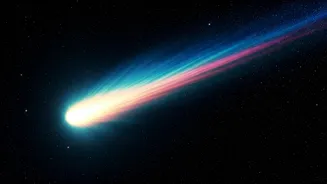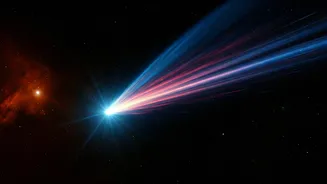Comet's Grand Voyage
The 3Ai Atlas interstellar comet is a celestial body journeying across vast distances. This event is not just a spectacle, but an opportunity to understand
the building blocks of other star systems. Studying such comets provides valuable information about their composition, offering clues about the early universe and how other solar systems might have formed. NASA and ESA are heavily involved in monitoring this comet, deploying missions designed to track its movement and gather data. These missions are equipped with specialized instruments to study the comet's tail and the gases it releases as it nears the sun, unlocking secrets about interstellar space.
Scientific Significance Unveiled
This cosmic event carries significant scientific weight, providing researchers with the rare opportunity to examine the chemistry of another star system. Comets, often considered 'dirty snowballs', are remnants from the formation of solar systems. They preserve materials from the early universe, allowing scientists to study the composition of celestial objects. Observing the 3Ai Atlas offers a unique perspective on the distribution of elements and molecules in interstellar space. This provides valuable insights into how different solar systems compare with our own. Understanding the properties of comets like 3Ai Atlas helps refine our models of the universe's evolution and the formation of planets. The data from missions tracking this comet will undoubtedly enrich our understanding of these distant, icy wanderers.
Tracking & Visibility Insights
Monitoring the 3Ai Atlas comet involves precise tracking to predict its position and visibility. Scientists utilize sophisticated instruments and telescopes to gather data on the comet's trajectory. These instruments measure the comet's position, speed, and brightness, creating detailed maps of its path through space. Depending on its trajectory, the comet may be visible from certain locations at specific times. The actual visibility of the comet depends on factors such as its brightness, the presence of light pollution, and the observer's location. Information about where and when to watch is often provided by space agencies and astronomical organizations, ensuring enthusiasts can witness this rare event.
Missions Tracking Comet
Both NASA and ESA have several missions dedicated to studying comets. These missions deploy advanced telescopes and spacecraft equipped with cutting-edge technology. They capture high-resolution images and collect spectroscopic data, analyzing the comet's composition. Specific missions will be focusing on the 3Ai Atlas, and their observations will offer invaluable insight into the comet's properties. The collaborative effort between these agencies exemplifies global cooperation in space exploration. The data gathered from these missions is shared among scientists worldwide, promoting deeper understanding. The data collected helps unravel the mysteries hidden in these celestial wanderers and contribute to our overall understanding of the universe.












